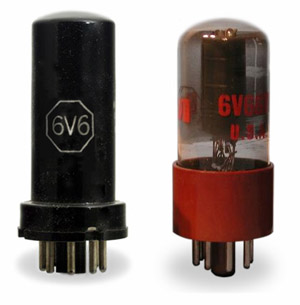
![]()
 Description
Description
This beam-power tetrode was similar to its predecessor, the higher powered
6L6 but more suitable to consumer usage due to a lower output and lower
heater voltage. It introduced beam-power tetrode technology on a large
domestic scale, and soon 6V6s were being found in many a radio output
stages and grammophones.
History
The 6V6 was introduced by RCA in late 1937 and was available in in both
metal and shouldered glass tubes. RCA was promoting the superiority
of its metal tube designs in the second half of the 1930s, and this
tube, having been introduced during that period, was produced in large
quantities in this format. Other manufacturers produced the 6V6 in glass
tubes, which were commonly found in 'non-RCA' radios. By 1940 the 6V6
was mostly being produced in a smaller "GT" glass envelope,
and later the 6V6GTA with a controlled warm-up period.
Current use
Generally 6V6 tubes are sturdy and can be run beyond their published
specifications. As a result, they became very popular for use in lower
power guitar amplifiers. This lucrative market allows tube factories
in China, Slovak and Russian to keep the 6V6 in production to this day.
|
Some
classic amps using the 6V6 / 6V6GT Current prices
|
||||||||||||||||||||

